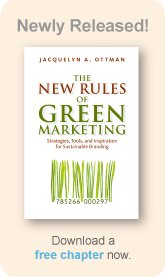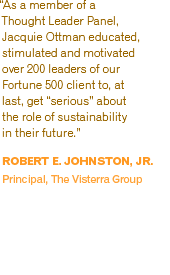Next-Generation Green Marketing: Beyond Billboards
By
Sustainable Life Media, October 2007
Green products are all the rage these days. Citing buzzwords such as
"non-toxic,"
"recyclable" and "sustainably
harvested," consumers are now scrutinizing products at every phase of their life
cycle, from the raw materials products are made of and how they are
manufactured, to distribution methods, marketing materials, in-use
impacts and how products are recycled or eventually disposed of. Weve
come a long way, baby! Or have we?
Some people are calling the
recent upswing in environmental discourse Green Marketing
implying a marked improvement over the corporate environmental
campaigns of yesteryear. Yet the flurry of irresponsible green
marketing practices today many of which are highly reminiscent of the
1990s suggest that Yogi Berras memorable "Its deja vu all over
again" may be a more appropriate tagline for the current state of affairs.
Green Marketing: Then and Now
In
1990, as Prince William Sound struggled to recover from Exxons tragic
Alaskan oil spill the year before, an unprecedented 100 million people
demonstrated their concern for the environment by celebrating the 20th
anniversary of Earth Day. Quick to capitalize on the green momentum,
businesses whipped up a slew of inventive green products and packages.
Some small successes persevered, like the U.S. EPAs Energy Star label
and the adoption of recycling codes for plastic bottles and
neighborhood recycling programs.
For the most part, however, things went badly wrong, prompting the Federal Trade Commission to step in and issue Environmental Marketing Guidelinesin 1992. Fifteen years later, these guidelines are in gross disregard.
Hybrid cars, fashions made from bamboo, and packages made from
cornstarch have been introduced to meet consumers green needs and
expectations. Unfortunately the ads, claims, and public relations
campaigns that go with them are not always legitimate.
Here are just a few examples of just how far weve truly come:
- Then:Wal-Marts green shelf-talkerƒ†â€™ƒÂ¢¢â€šÂ¬…¡ƒ¢â‚¬Å¡ƒâ€š‚ program was quickly disbanded when pressed by environmental advocates for misleading consumers.Now: Wal-Marts failed marketing attempt looks a lot like Home Depots Eco Optionsƒ†â€™ƒÂ¢¢â€šÂ¬…¡ƒ¢â‚¬Å¡ƒâ€š‚ÂÂÂprogram, which aims to have more than 6,000 items labeled by 2009. Like Wal-Mart, Home Depot runs the risk of misleading consumers. With so many Eco Options products on store shelves, will consumers be able to differentiate the green from the not so green?
- Then: 90% of Mobil's “Hefty" "biodegradable" trash bags wound up in landfills (not compost heaps) where they wereunable to degrade due to lack of exposure to the elements. Now: The now-defunct Biota Companypackaged its water in bottles made from cornstarch. Though a bold neck tag promised "biodegradable," many of the bottles like Heftys trash bags were destined for landfills. To make matters worse, the clear plastic bottles could be mistaken for PET bottles and had the potential to contaminate recycling streams.

In
order to avoid the wrath of consumers and government agencies, industry
must exchange dubious green marketing practices for sustainable
branding: reaching out to employees and a broad range of external
stakeholders, using multidisciplinary teams to develop greener products
and marketing programs, and maintaining good relations with the
community.
The Real
"2.0"
Like
polar bears, companies are naively plodding their way along thin ice.
Environmental issues are understood to be more serious today than they
were during the first iteration of green marketing (think climate
change), and consumers are shopping with a vengeance , and a
conscience. Industry is duly warned to adopt a more responsible green
marketing course or risk inviting regulation on such flagrantly dubious
green marketing practices. Note the rise of grassroots bans on
polluting products such as bottled water, supermarket shopping bags,
and the like. Will products with large carbon footprints, like bananas,
coffee, and even the much-heralded bamboo be next?
Consider
this: Developing entirely new product concepts brings the potential for
significantly enhanced consumer benefits. Benefits that dont need
eco-labels, Kermit the Frog or any other slick green marketing stunt.
Youre on an eco-innovative track when you have:
- Introduced a new product concept, like Apples iPod which bestows obvious consumer benefits along with the environmental attributes of streamlining the production and transportation of CDs.
- Attempted to affect an entire system. Chevys Volt electric car is slated to be positioned as a second car, ideal for commuting and errands.
- Provided the consumer with services rather than products.Car sharing services, which promote intensive use of fewer cars while providing the consumer with all the benefits of renting, all the benefits of ownership without the hassle, are a great example.
Companies must look toward eco-innovation, shunning incremental upticks for the radical improvements in environmental performance that will be necessary given the magnitude of the environmental ills that now face us. Devising clever services that minimize production processes, transportation needs, energy use, and storage requirements can lead to waterfalls of profits for businesses, the public, and the environment. Its not the easiest route to being green, but theres something to be said for learning from and capitalizing on past mistakes.
__________
This article has been adapted from Jacquelyn Ottmans keynote speech to Sustainable Brands '07 in New Orleans, September 27, 2007.



 ShareThis
ShareThis
Jacquelyn Ottman is president of J. Ottman Consulting, Inc., a New York-based marketing consulting firm that specializes in helping businesses derive competitive advantage from eco-innovation and green marketing. She is the author of Green Marketing: Opportunity for Innovation, 2nd edition.
Contact Us to learn more about J. Ottman's green marketing services.
Follow Jacquie on Twitter
Read Jacquie Ottman's Green Marketing Blog
Copyright© 2008 by J. Ottman Consulting, Inc.


